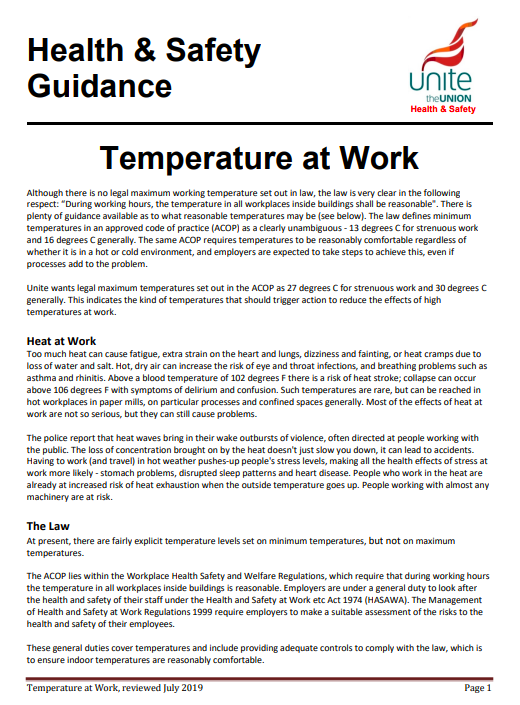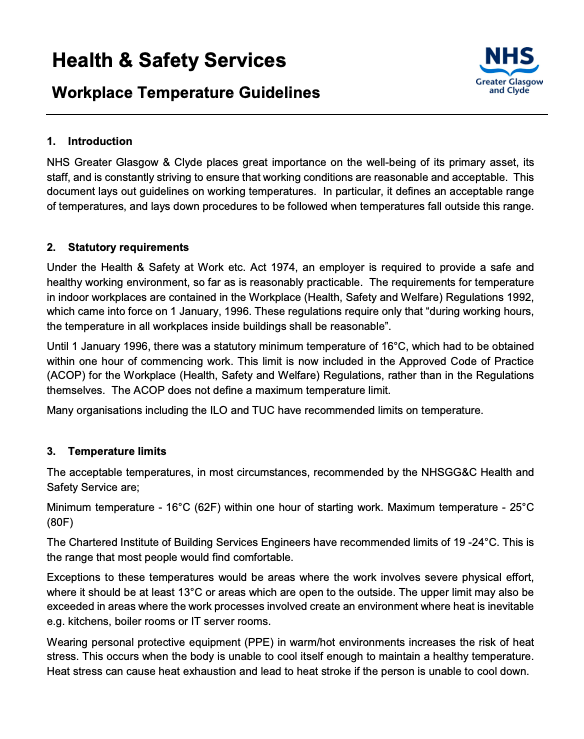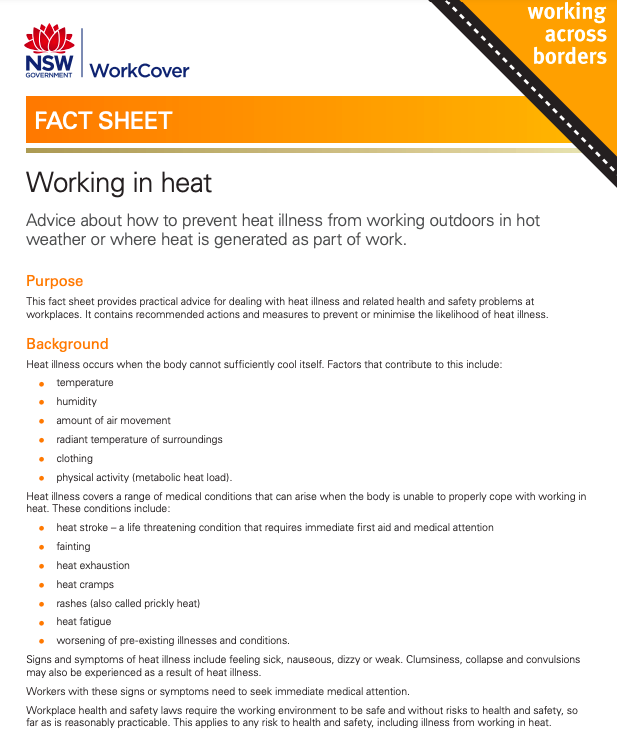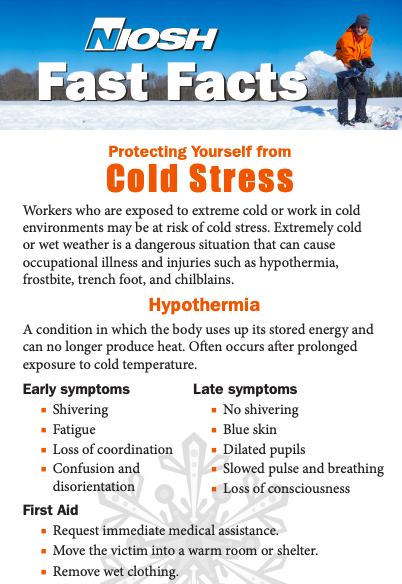Temperature at Work – is it an issue?
The temperature in the workplace can have a significant impact on the comfort and productivity of employees. If the temperature is too hot or too cold, it can lead to discomfort and distraction, making it difficult for employees to concentrate on their work. There are a few key issues to consider when it comes to temperature in the workplace:
- Comfort: As mentioned above, the temperature in the workplace should be comfortable for employees. This may vary depending on the type of work being done and the personal preferences of individual employees, but a general guideline is to aim for a temperature of around 68-72 degrees Fahrenheit (20-22 degrees Celsius).
- Health and safety: Extreme temperatures can also have negative impacts on the health and safety of employees. For example, if the temperature is too hot, it can lead to dehydration, heat stroke, and other heat-related health problems. On the other hand, if the temperature is too cold, it can lead to hypothermia, frostbite, and other cold-related health problems.
- Productivity: Finally, temperature can also affect the productivity of employees. Studies have shown that workers are most productive when the temperature is within a comfortable range, and that productivity tends to decline as the temperature moves outside of this range.
Overall, it is important to ensure that the temperature in the workplace is comfortable and conducive to productivity. If you have concerns about the temperature at your workplace, it is important to raise them with your employer or HR department.
Is there any legislation in the UK that regulates temperature at work?
In the United Kingdom, the Health and Safety at Work etc. Act 1974 (HSW Act) sets out the general duties of employers to ensure the health, safety, and welfare of their employees while at work. This includes taking steps to provide a safe and healthy working environment, including maintaining an appropriate temperature in the workplace. The Workplace (Health, Safety and Welfare) Regulations 1992 provide more specific guidance on the temperature of the workplace. These regulations state that the temperature in the workplace should be “reasonable,” taking into account the nature of the work being carried out and the type of workplace. There is no specific temperature range that is defined as “reasonable” under the regulations, but a general guideline is that the temperature in the workplace should be at least 16 degrees Celsius (61 degrees Fahrenheit) if the work involves physical activity, and at least 13 degrees Celsius (55 degrees Fahrenheit) if the work is sedentary. Employers are also required to provide adequate heating, ventilation, and cooling systems to maintain a comfortable temperature in the workplace. If employees are concerned about the temperature in the workplace, they can raise the issue with their employer or contact the Health and Safety Executive (HSE) for advice.
Do women feel the cold more than men?
There is some evidence to suggest that women may be more sensitive to cold temperatures than men, but the relationship between gender and sensitivity to cold is complex and not fully understood. One factor that may contribute to differences in sensitivity to cold between men and women is differences in body composition. On average, men have a higher percentage of muscle mass and a lower percentage of body fat compared to women. Because muscle generates more heat than fat, men may be able to maintain their body temperature more effectively in cold environments than women. Hormonal differences between men and women may also play a role in sensitivity to cold. For example, women have higher levels of estrogen, which may affect their ability to regulate body temperature. It is important to note that individual differences in sensitivity to cold can vary greatly, and that both men and women can experience discomfort in cold environments. It is important to dress appropriately for the weather and to take steps to maintain a comfortable body temperature in cold environments.
How can employers resolve arguments about temperature at work?
If there are disagreements about the temperature in the workplace, there are a few steps that employers can take to try to resolve the issue:
- Consult with employees: It is important for employers to listen to the concerns of their employees and take them into account when setting the temperature in the workplace. Employers can consult with employees to gather feedback and try to find a temperature that is comfortable for the majority of people.
- Use a thermostat: Employers can install a thermostat in the workplace to help maintain a consistent temperature. This can be set to a comfortable temperature that has been agreed upon by employees.
- Encourage employees to dress appropriately: Employees can help regulate their own body temperature by dressing appropriately for the weather. Employers can encourage employees to wear layers and to bring additional clothing, such as sweaters or jackets, to help stay comfortable in the workplace.
- Consider individual needs: Some employees may have health conditions or other individual needs that make them more sensitive to temperature. Employers should be mindful of these needs and take steps to accommodate them, such as providing additional heating or cooling for these employees.
- Seek professional help: If the temperature in the workplace is causing ongoing problems or disputes, it may be helpful to seek the advice of a professional. An occupational health and safety specialist or a heating and cooling engineer can assess the workplace and provide recommendations for maintaining a comfortable temperature.
Do employers have a duty to consider temperature at work for staff working from home?
Employers have a duty to ensure the health and safety of their employees while they are at work, regardless of whether they are working in an office or from home. This includes taking steps to ensure that the work environment is safe and comfortable. If employees are working from home, employers should encourage them to create a comfortable and safe work environment, including maintaining an appropriate temperature. This may involve providing guidance or resources to help employees set up their home workspace, such as recommendations for heating and cooling systems or tips for dressing appropriately for the weather. Employers should also be aware that some employees may have specific needs or requirements related to temperature, such as those with health conditions that make them more sensitive to extreme temperatures. Employers should make an effort to accommodate these needs and ensure that employees are able to work in a comfortable environment. If employees are working from home and are concerned about the temperature in their home workspace, they should raise the issue with their employer. The employer should take steps to address the issue and ensure that the employee is able to work in a comfortable and safe environment.
Do employers have to pay for heating costs for employees working from home?
In the United Kingdom, employers are not required to pay for heating costs for employees working from home. However, they do have a duty to ensure the health and safety of their employees while they are at work, including ensuring that the work environment is safe and comfortable. If an employee is working from home and is concerned about the temperature in their home workspace, they should raise the issue with their employer. The employer should take steps to address the issue and ensure that the employee is able to work in a comfortable and safe environment. This may involve providing guidance or resources to help the employee set up their home workspace, such as recommendations for heating and cooling systems or tips for dressing appropriately for the weather. Employers should also be aware that some employees may have specific needs or requirements related to temperature, such as those with health conditions that make them more sensitive to extreme temperatures. Employers should make an effort to accommodate these needs and ensure that employees are able to work in a comfortable environment.
How should employees complain if they feel to cold or too hot at work?
If an employee is concerned about the temperature in the workplace, it is important for them to raise the issue with their employer or HR department. Here are a few steps that employees can follow when making a complaint about the temperature at work:
- Document the problem: It can be helpful to keep a record of the temperature in the workplace and any related issues, such as discomfort or decreased productivity. This can help to support your complaint and provide evidence of the problem.
- Talk to your supervisor or HR representative: If you have concerns about the temperature in the workplace, it is important to raise the issue with your supervisor or HR representative. They will be able to address your concerns and take steps to resolve the issue.
- Be respectful and professional: It is important to approach the conversation in a respectful and professional manner. Avoid being confrontational or accusatory, and focus on the specific issues that you are experiencing.
- Offer solutions: If possible, try to come up with some potential solutions to the problem. This can help to show that you are proactive and willing to work together to find a resolution.
- Follow up: If the issue is not resolved to your satisfaction, consider following up with your supervisor or HR representative to ensure that the issue is being addressed.
It is important to remember that employers have a duty to ensure the health and safety of their employees, including providing a comfortable and safe work environment. If you have concerns about the temperature in the workplace, it is important to raise them with your employer or HR department.
Can you provide an example of a temperature at work policy?
Sure! Here is an example of a temperature at work policy that an employer might use: Temperature at Work Policy Our goal at [Employer] is to provide a comfortable and safe work environment for all employees. To achieve this goal, we have established the following policy on temperature at work:
- The temperature in the workplace should be reasonable and comfortable for all employees, taking into account the nature of the work being carried out and the type of workplace.
- The temperature in the workplace should be maintained at a minimum of 16 degrees Celsius (61 degrees Fahrenheit) if the work involves physical activity, and at least 13 degrees Celsius (55 degrees Fahrenheit) if the work is sedentary.
- Adequate heating, ventilation, and cooling systems should be provided to maintain a comfortable temperature in the workplace.
- Employees who are concerned about the temperature in the workplace should raise the issue with their supervisor or HR representative.
- If the issue is not resolved to the employee’s satisfaction, they may contact the Health and Safety Executive (HSE) for advice.
- The company will make reasonable efforts to accommodate the needs of employees with health conditions or other individual needs related to temperature.
By following this policy, we aim to ensure that all employees are able to work in a comfortable and safe environment.
What online resources are available for employers who want to learn more about temperature at work?
Here are some online resources that employers can use to learn more about temperature at work and how to maintain a comfortable and safe working environment for their employees, along with the URLs for each resource:
- Health and Safety Executive (HSE): The HSE is the UK government agency responsible for ensuring that workplaces are safe and healthy. They have a number of resources available on their website related to temperature at work, including guidance on the Workplace (Health, Safety and Welfare) Regulations 1992.
- Acas: Acas is an independent organization that provides advice and support on workplace issues, including health and safety. They have a number of resources available on their website related to temperature at work, including guidance on how to maintain a comfortable temperature in the workplace.
- Chartered Institute of Environmental Health (CIEH): The CIEH is a professional organization that provides training and resources on environmental health and safety issues. They have a number of resources available on their website related to temperature at work, including guidance on how to maintain a comfortable temperature in the workplace.
- Health and Safety Executive (HSE) Temperature at Work: This webpage on the HSE website provides guidance on the Workplace Regulations and how to maintain a comfortable temperature in the workplace.
URL: https://www.hse.gov.uk/temperature/employer/the-law.htm
- Acas Managing temperature at work: This webpage on the Acas website provides guidance on how to maintain a comfortable temperature in the workplace, including tips for setting the thermostat and dressing appropriately for the weather.
URL: https://www.acas.org.uk/when-extreme-weather-affects-work By using these resources, employers can learn more about their responsibilities related to temperature at work and how to create a comfortable and safe working environment for their employees.









